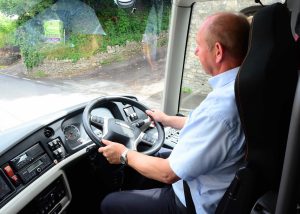Drivers contend with an extensive list of regulations governing their working hours, vehicle checks and compliance records, from the EU drivers’ hours rules to the Transport Act, GB Domestic rules, and post-Brexit changes wherein PCV and LGV drivers are subject to different rules — the latter being a recipe for confusion where different sets of drivers start exchanging information in forums and break rooms.
CEO of the Association of Trainers Ross Lockett has raised concerns over the complexity of the rules and of the risks of regularly allowing drivers to work the maximum permitted time as stipulated. He highlights a need for a more proactive industry approach that would ensure safety, compliance, and driver wellbeing.
A structured approach
Current EU regulations state a driver must take a break of at least 45 minutes after no more than four-and-a-half hours of driving, with an option to split the break. Mr Lockett argues that this rule is often misinterpreted as meaning drivers can work behind the wheel for the stated time without a break. This has created a culture where breaks are minimised, instead of being optimised for safety and efficiency.
Instead, Mr Lockett advocates a structured and sensible approach to coach journey planning. He points to Rule 91 of the Highway Code which states that a minimum break of ‘at least 15 minutes after every two hours of driving’ is recommended.
In short, instead of allowing a driver to complete a four-hour journey without pause, a planner should factor in a 15-minute break at the two-hour mark. The remaining break can be scheduled at the destination before the return leg. This model complies with EU regulations while aligning with best practice for driver wellbeing and safety.
“Consider a journey from A to B which takes four hours,” says Mr Lockett. “In the plan, if the driver, transport manager and planner within the business start at 0600hrs, and need to make that journey, then they should arrive by 1000hrs.
“However, we need to consider many other factors. I would start the driver at 0500hrs for the 1000hrs arrival at destination, for checking the vehicle, which can take up to 30 minutes; for factoring in any difficulties on the road; and a 15-minute break after two hours of driving.”
Implementing the break would only add approximately 15 minutes to a driver’s workday but could lead to major benefits, including reduced stress, improved concentration and a better experience for passengers. It also reduces likelihood of rule infringements and subsequent penalties.
“A driver getting time away from the wheel every two hours allows his or her mind to relax and focus away from the dynamics of driving, as well as focusing in on requirements to be fit to operate a vehicle and keep good repute,” Mr Lockett adds. “Any director or transport manager should take a serious look at themselves if they are running drivers so tight for time and utilising hours in such a pressured manner. The rules are there to protect drivers, transport companies, their passengers and other road users. The repute of all concerned can be called into question if they are in contravention of any rules.”
Tangible benefits
One company that has seen benefits from the implementation of this structure is Earned Recognition (ER) and Guild of British Coach Operators member Country Lion.
Paul Shaw, who has been Transport Manager at the company for some 17 years, takes the attitude that drivers’ hours should be seen in the same way as speed limits — namely that they are limits, not targets. “There is the perceived idea that other operators may try and push things to the limit,” he acknowledges. “It varies from operator to operator, but at Country Lion we have adopted a two-hour rule for many years now.”
That rule began circa 1984 when one of the operator’s clients, Carefree Holidays (which Country Lion acquired as Cloud Nine Holidays in the 1990s) requested that drivers were to drive no more than two-hours before a break. That rule was initially for passenger comfort, but it quicky became apparent that drivers also benefited greatly from the policy.
“What we’ve done is stipulate 20 minutes after two-hours of driving, because inevitably there will be one or two passengers not as quick at disembarking,” Mr Shaw says. “It has kept drivers more alert, and they are more refreshed when they get to their destination, so we expanded that rule as much as we could across the business.
“It has not added costs — we plan it when doing the holiday and excursion itineraries — and it was easy to put into the schedule. There was a bit of education needed for drivers, particularly those not engaged in holiday work, to get them into the mindset.”
Mr Shaw reveals that fatigue associated incidents with drivers are virtually non-existent at Country Lion as a result, and drivers’ hours infringement levels are very low thanks to frequent breaks. There are exceptions when the two-hour break rule cannot be implemented — when sports teams have deadlines for fixtures, for example — but in most planning, there’s little reason it cannot be accomplished. “Our experience of changing is a positive one and I would encourage it being rolled out more widely,” he says.
Toolbox talks
Mr Shaw acknowledges the complicated nature of drivers’ hours rules and training plays a huge part when onboarding new team members. Keeping infringement levels low is critical. New staff are retrained on drivers’ hours expectations and are mentored for two weeks. The change can be dramatic for those who join from scheduled coach work, where long hours behind the wheel are the norm.
“We see tangible benefits by doing it. There must be other operators out there that will see the same benefits. While we don’t want to suggest our way of working is best — what matters is that companies run safely and legally — by pushing drivers right to the limit, you leave yourself more open to the chance of issues and failures. If someone consistently drives four-and-a-half hours before they take a break, it only leads to fatigue.”
Mr Lockett recommends regular toolbox talks on key compliance topics such as drivers’ hours to ensure all drivers apply the regulations to their day-to-day operations. A recent concern has been the six-hour working rule under the Working Time Directive: “This is a common issue later in the day, where a driver has exceeded six hours due to taking break or breaks too early in the day. The driver will be invited in to sign an infringement, and often this will be discussed but not to an in-depth level.
“Legally the operator must address and ensure ‘the rules on drivers’ hours and tachographs are observed and proper records are kept’. One of the ways a transport company could address this would be a toolbox talk to all drivers at very little cost, except time.”
Doing so will help eliminate stress for managers and drivers — and while it cannot undo an infringement, to follow up with a talk makes all staff aware that such issues must cease, and in a way that is far better to all staff to understand and acknowledge.






























